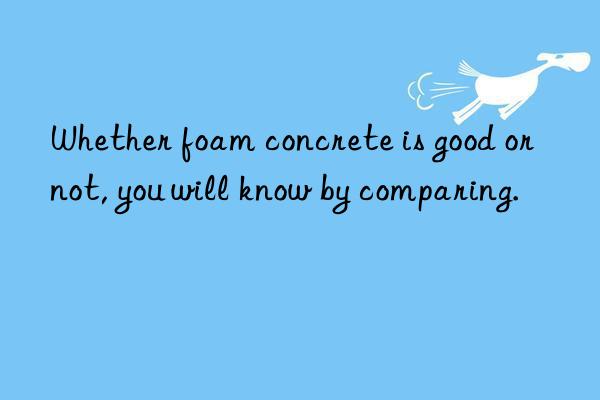
1. Light: Foam concrete with a density between 200-700kg/m3 is currently used on the market. The density is 1/4 to 1/15 of concrete. 1/3~1/10 of the building load can be effectively reduced;
2. Fast: Foam concrete is a fluid slurry during construction, and is made with special equipment and pumps Delivery, construction saves manpower and material resources, and the surface is smooth and smooth after solidification; the production capacity of a single equipment is 10 to 120m3/hour, the construction speed is extremely fast, and the construction period is compressed;
3. Construction Convenience: The production point of foam concrete can be separated from the on-site construction and pouring point. The production space is small, it does not occupy other construction equipment, does not affect the construction of other sections, and is less affected by the weather. Since foam concrete does not contain the coarse aggregate of cement concrete, its fluidity is much higher than that of cement concrete. It can be pumped through hoses during actual construction, making construction convenient;
4. Insulation: The thermal conductivity of commonly used foam concrete is between 0.045 - 0.20w/m.k. It is used for insulation purposes such as building roofs, exterior walls, floor heating insulation layers, and frozen soil protection in alpine areas. It has a very competitive advantage;
5. Sound insulation: The special porous structure of foam concrete has greater resistance to sound waves. The sound insulation performance is 5-8 times that of ordinary cement. It can be used as floor cushion. Solve the sound insulation problem between layers;
6. Adjustable strength: The strength of foam concrete is directly proportional to the density. During construction, the pores in the foam concrete can be adjusted Content, the dry density of foam concrete can be controlled between 200 and 1600kg/m3, and the strength can be adjusted within the range of 0.3~7.55Mpa (the main application range of strength in engineering is 0.3~1.5Mpa).
7. Fluidity: Since foam concrete does not contain coarse aggregate, its fluidity is much higher than that of cement concrete, and it has self-leveling characteristics during construction; and the pouring point It occupies a very small construction space and can be constructed in a small space; combined with filling, it is self-compacting and does not require vibrating and rolling.
8. Integrity: Foam concrete is made of cement. The curing agent is cast as a whole and solidifies to form a super-consolidated state. After curing, it has the characteristics of being self-reliant as a whole and has no lateral pressure on other structures;
10. Low elasticity and earthquake resistance : Foam concrete has low density and is subject to small horizontal inertial force; at the same time, foam concrete has low elastic modulus and good impact energy absorption performance. It has good cushioning properties for building structures and protects building structures from impact damage. The elastic modulus and compressive strength of foam concrete show a good linear relationship, and Ec=250qu is generally used in engineering;
9. Fire safety: Foam concrete is an inorganic material (cement), does not burn, does not deform when exposed to fire, has no thermal decomposition, fire safety level - A1 level non-combustible, used on buildings, can improve the fire protection performance of the building;
11. Durability: Foam concrete is a cement-based material with the same service life as cement concrete and has excellent durability and fatigue resistance;
12. Environmental protection: The main raw materials of foam concrete are ordinary Portland cement and foaming agent. The foaming agent ingredients are mainly plant protein fibers and animal proteins. They are safe and non-toxic to the human body and are harmful to soil, water, air and other natural environments. They are non-polluting and have excellent environmental protection properties. </p

 微信扫一扫打赏
微信扫一扫打赏

